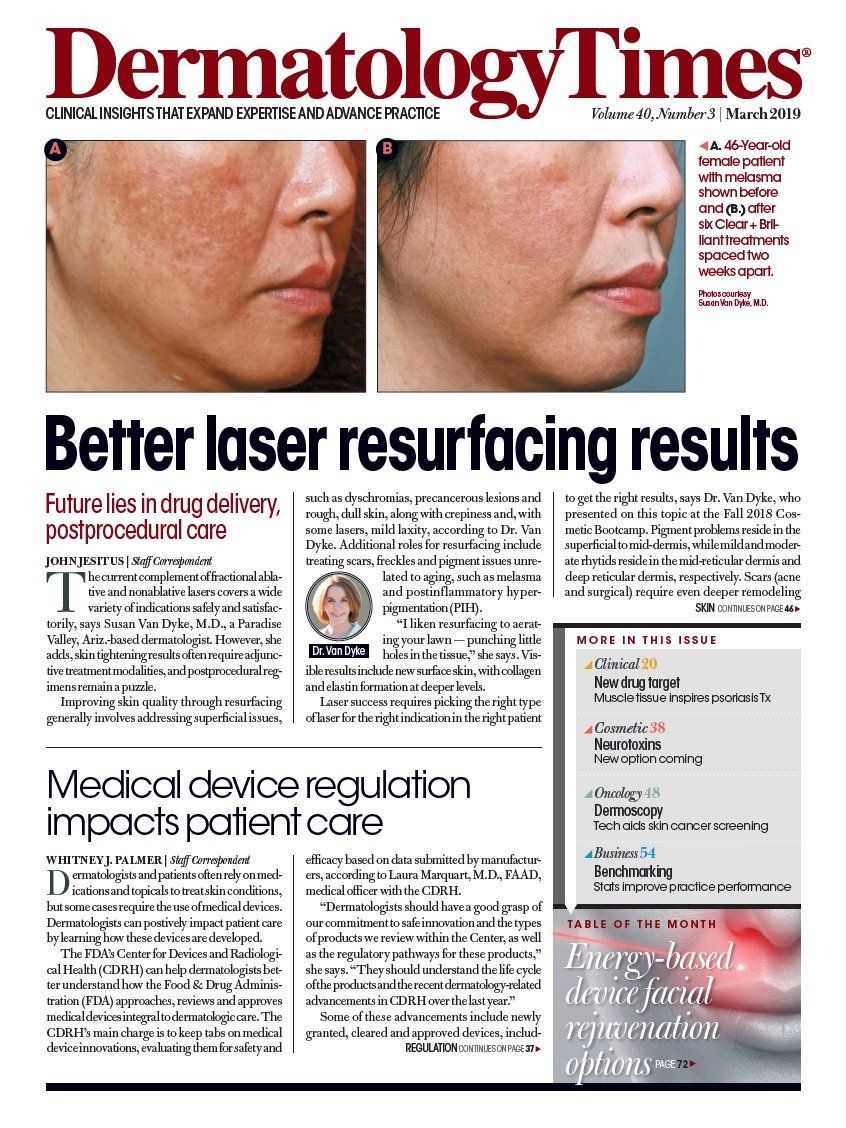- Case-Based Roundtable
- General Dermatology
- Eczema
- Chronic Hand Eczema
- Alopecia
- Aesthetics
- Vitiligo
- COVID-19
- Actinic Keratosis
- Precision Medicine and Biologics
- Rare Disease
- Wound Care
- Rosacea
- Psoriasis
- Psoriatic Arthritis
- Atopic Dermatitis
- Melasma
- NP and PA
- Skin Cancer
- Hidradenitis Suppurativa
- Drug Watch
- Pigmentary Disorders
- Acne
- Pediatric Dermatology
- Practice Management
- Prurigo Nodularis
- Buy-and-Bill
Publication
Article
Dermatology Times
Future of skin resurfacing lies in drug delivery, postprocedural care
Author(s):
Fractional ablative and nonablative lasers cover a wide variety of indications, but skin tightening results often require adjunctive treatment modalities and postprocedural regimens remain a puzzle, says Susan Van Dyke, M.D.
Fractional ablative and nonablative lasers cover a wide variety of indications, but skin tightening results often require adjunctive treatment modalities and postprocedural regimens remain a puzzle, says to Susan Van Dyke, M.D. (Nadezhda - stock.adobe.com)

Dr. Van Dyke

The current complement of fractional ablative and nonablative lasers covers a wide variety of indications safely and satisfactorily, says Susan Van Dyke, M.D., a Paradise Valley, Ariz.-based dermatologist. However, she adds, skin tightening results often require adjunctive treatment modalities, and postprocedural regimens remain a puzzle.
Improving skin quality through resurfacing generally involves addressing superficial issues, such as dyschromias, precancerous lesions and rough, dull skin, along with crepiness and, with some lasers, mild laxity, according to Dr. Van Dyke. Additional roles for resurfacing include treating scars, freckles and pigment issues unrelated to aging, such as melasma and postinf lammatory hyperpigmentation (PIH).
“I liken resurfacing to aerating your lawn - punching little holes in the tissue,” she says. Visible results include new surface skin, with collagen and elastin formation at deeper levels. Laser success requires picking the right type of laser for the right indication in the right patient to get the right results, says Dr. Van Dyke, who presented on this topic at the Fall 2018 Cosmetic Bootcamp. Pigment problems reside in the superficial to mid-dermis, while mild and moderate rhytids reside in the mid-reticular dermis and deep reticular dermis, respectively. Scars (acne and surgical) require even deeper remodeling with more aggressive lasers, she says, although treating the reticular dermis too aggressively can generate scars.
DEEP TREATMENTS
Deep ablative treatments generally address moderate-to-severe photodamage and scars, according to Dr. Van Dyke. In the past, fully ablative CO2 lasers used with multiple passes at 50% overlap penetrated to the reticular dermis.
“Patients almost always lost their pigmentation, but the results were spectacular,” she says. Despite short procedure times with a single treatment, immediate tightening and long-term collagen stimulation, “...you had to do this procedure under general anesthesia.” Along with pigment loss, patients experienced weeks of skin oozing, weeping and crusting. Thus the procedure fell out of favor in the late 1990s.
“Therefore, we went from fully ablative treatments, destroying everything in sight, to fractional treatments,” which leave bridges of normal tissue between ablated columns to speed healing. “That’s why we’re getting healing in seven to eight days, even when I treat aggressively. And I’ve not seen anybody lose pigment with fractional CO2 laser treatment.”
A single treatment provides improvements in tone and texture. “It’s rare for a patient to say, ‘I’m not happy with my results.’ You also get immediate tightening with the fractional CO2 - you can see it while you’re doing it.” However, these results are less dramatic than with fully ablative CO2. So she combines fractional CO2 with other modalities such as Thermage (Solta Medical) or Ultherapy (Merz Aesthetics).
Incidence of adverse events (AEs) after deep ablative fractional resurfacing remains fairly significant, says Dr. Van Dyke. In a study1 of 490 treatments performed in 374 patients published in 2011, the overall AE rate was 13.6%.
The most common AEs were infection (5.7%) and acneiform reactions to topical products (5.3%). “Even though all these companies make these fancy post-procedural care products,” she says, “I have yet to find one that I can use on a patient after CO2 laser. I always go back to Aquaphor (Johnson & Johnson).”
Additionally, yeast infections and bacterial infections impact around five percent of the patients Dr. Van Dyke treats with CO2 laser. She typically puts these patients on empirically guided antibiotics and prescribes vinegar soaks to sooth the skin and combat yeast infection.
“And I see these patients very frequently - on day one, day four and day seven. If they’re going to get an infection, it happens on day four or five. With minocycline and fluconazole, I’ve not had any scarring or antibiotic resistance in over 1,000 patients.”
MEDIUM-DEPTH RESURFACING
Nonablative fractional lasers can handle mild-to-moderate photodamage and scars, according to Dr. Van Dyke. With these lasers, optimal results usually require three to six sessions. Because the stratum corneum remains intact, she says, these treatments require no wound care or clinical downtime - just two to four days of social downtime. Although nonablative fractional treatments can approach the results of fully ablative resurfacing, Dr. Van Dyke adds, nonablative fractional treatments do not tighten skin.
The Fraxel Restore laser (Solta Medical) provides significant leeway in terms of aggressiveness, she says, depending on skin type. For acne scars, such as boxcar and ice-pick scars in African-American patients, Dr. Van Dyke says, repetitive nonablative fractional treatments provide better results than CO2 laser.
SUPERFICIAL RESURFACING
Dr. Van Dyke’s low-power nonablative fractional laser of choice, the Clear + Brilliant (Solta Medical), offers 1,440 nm and 1,927 nm wavelengths and delivers about 1/10 the power of her work horse Fraxel Restore. Treatment offers minimal discomfort with excellent outcomes, usually with six or more treatments.
Additionally, she commonly performs low-energy nonablative fractional treatments every couple months after medium or deep laser resurfacing as maintenance therapy.
Low-energy nonablative fractional lasers require no downtime. “It’s like polishing an apple - to refresh, treat fine lines and remove pigment. This is my go-to treatment for melasma, combined with hydroquinone four percent at the time of treatment.” Rather than using hydroquinone between appointments, her patients typically use a non-hydroquinone brightener such as Lytera (SkinMedica/Allergan) or Even Tone Correcting Serum (Skinbetter Science).
Dr. Van Dyke has seen no adverse events with this laser. She uses the 1,440 nm wavelength for fine lines, texture and tone.
“The 1,927 wavelength has been shown to open micropores in tissue... a great drug-delivery system.” Applying topical medications such as hydroquinone or vitamin C immediately post-treatment allows them to penetrate the epidermis, she says.
As for the future, Dr. Van Dyke says that the lasers already available allow doctors to tailor treatments to individual patients. “The real future is in the drug-delivery area, with hydroquinone, antioxidants, platelet-rich plasma and post-procedural skincare regimens.”
Post-procedural regimens remain a bigger challenge, says Dr. Van Dyke, who tests some regimens for drug developers. Yet she remains optimistic that manufacturers will conquer this hurdle.
Disclosures: Dr. Van Dyke has been a speaker, investigator or advisor for Allergan, Galderma, Merz and Valeant.
Reference1 Shamsaldeen O, Peterson JD, Goldman MP. The adverse events of deep fractional CO(2): a retrospective study of 490 treatments in 374 patients. Lasers Surg Med. 2011;43(6):453-6.






